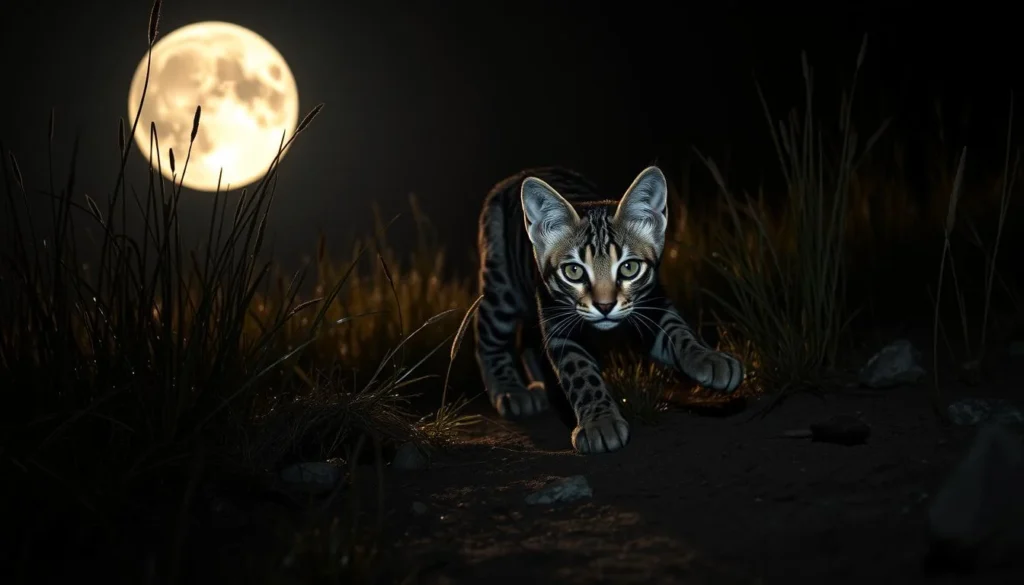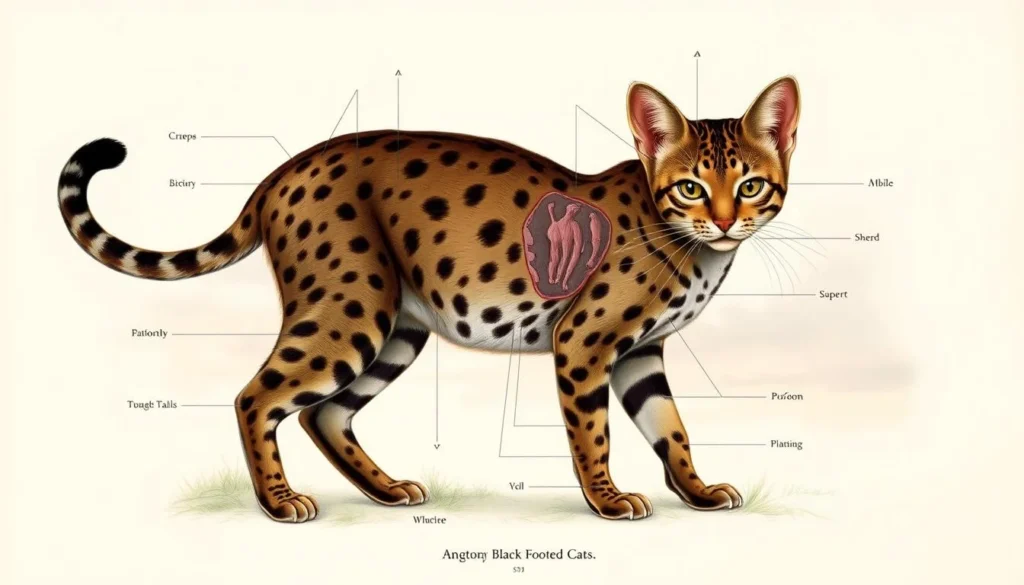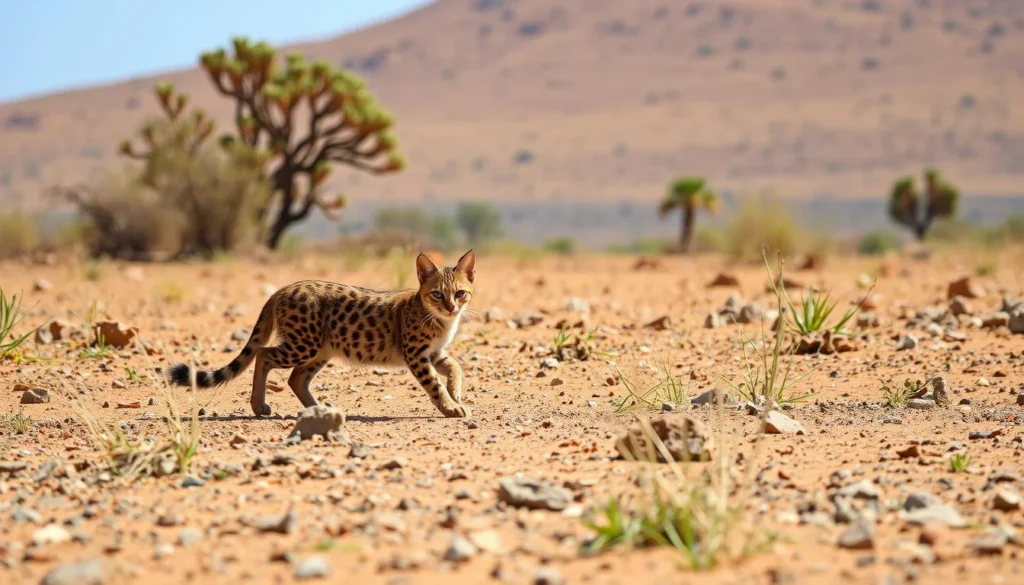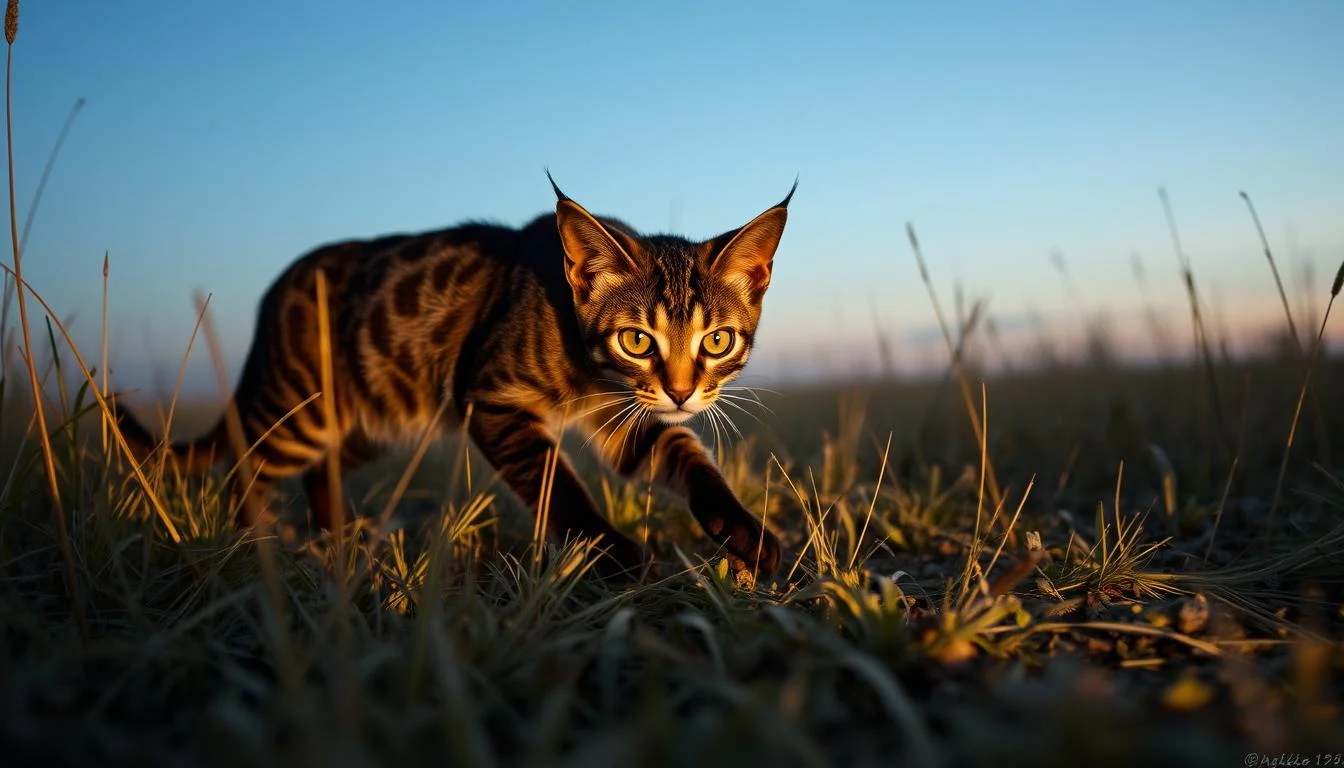Table of Contents
In southern Africa’s sandy lands, a hidden predator exists. It’s a small wild cat that will surprise you. The black-footed cat looks simple but is a fierce hunter.
This cat weighs just a few pounds but is incredibly skilled. It has a 60% success rate in hunting. That’s better than lions and cheetahs.
Wildlife experts are amazed by this small cat. It shows that size doesn’t matter when it comes to hunting. Every night, these cats turn into deadly hunters in the African wild.
Key Takeaways
- The black-footed cat is considered the world’s deadliest small wild cat
- They have an incredible 60% hunting success rate
- Native to southern African regions
- Smaller than typical house cats
- Exceptional nocturnal predators
Meet the Mighty Hunter: Introduction to the Black Footed Cat

In the vast African landscapes, the black-footed cat stands out. It’s a small but mighty predator. This tiny hunter is known for its incredible skills, making it a top nocturnal hunter.
These cats are small, weighing 1.7 to 2.4 kg. Yet, they are legendary among wildlife fans. They hunt better than lions and leopards, catching 60% of their prey. Each night, they eat 8 to 14 meals, showing their unmatched hunting skill.
- Native to Botswana, Namibia, and South Africa
- Primarily inhabit savannas, grasslands, and desert regions
- Can survive at elevations up to 6,600 ft
- Estimated population of approximately 10,000
Understanding these cats is more than just their size. They have vision six times sharper than humans. This helps them navigate their tough environments with great precision. They are true survival experts in Africa’s toughest ecosystems.
“Small in size, but giant in spirit” – Wildlife Conservation Research Team
These cats face big challenges. Habitat loss and human conflicts threaten them. Conservation efforts are key to their survival in the wild.
Physical Characteristics and Anatomy
The black-footed cat is a remarkable example in the world of feline conservation. These small predators have a unique design that helps them hunt well.
Size and Weight Specifications
Black-footed cats may be small, but they are mighty. Their size shows how well they are adapted:
- Average body weight: 1.5-2.5 kg (3.3-5.5 lbs)
- Body length: 35-52 cm (14-20 inches)
- Shoulder height: 20-25 cm (8-10 inches)
Distinctive Physical Features
These cats have features that make them stand out:
- Dense, sandy-colored fur with distinctive black spots
- Large, rounded ears for exceptional hearing
- Powerful muscular build relative to their size
- Dark-colored paw pads with black fur between toes
Specialized Hunting Adaptations
These cats have special traits for hunting:
- Exceptional night vision for nocturnal hunting
- Muscular hind legs enabling rapid, precise pouncing
- Camouflage coat blending perfectly with desert environments
- Sharp, retractable claws for efficient prey capture

Distribution and Natural Habitat

The black-footed cat lives in some of the toughest landscapes in southern Africa. It has adapted well to the harsh conditions of Namibia, Botswana, and South Africa. Knowing where this cat lives is key to understanding it.
These cats are built for survival in extreme places. They find a special place in African wildlife. They live in areas with very little rain, usually between 100 to 500 mm. They move through these areas with amazing skill.
- Primary habitat regions include:
Southern African savannas
Desert and semi-desert environments
Grasslands with sparse vegetation
Female black-footed cats have home ranges of 6.23 to 15.53 km². Males have slightly bigger territories, 19.44 to 23.61 km². They travel up to 16 km each night, looking for food in their harsh home.
“The black-footed cat represents nature’s ultimate survivor in one of the world’s most unforgiving landscapes.” – Wildlife Research Expert
Population densities change a lot, from 0.03 to 0.17 individuals per square kilometer. These changes show how tough their environment is. Survival here requires incredible adaptability in African wildlife.
The World’s Most Successful Hunter
The black-footed cat is a top hunter in the desert. It’s small but very good at catching prey. This cat is known for being one of the best hunters in the world.
This cat’s hunting skills are amazing. It can catch prey better than big animals like lions and wolves. It has a 60% success rate, which is very high.
Impressive Hunting Statistics
- Takes down up to 14 small animals each night
- Can jump 5 feet high and cover 6½ feet in a single leap
- Hunts with a success rate three times that of wolves
Hunting Techniques and Strategies
Black-footed cats hunt at night. They are very quiet and fast. They stalk their prey and then run very quickly.
“Size doesn’t determine hunting ability – skill and adaptation do.” – Wildlife Researcher
Prey Selection and Diet
These cats eat a variety of things in the desert. They hunt small mammals, birds, and sometimes reptiles and bugs. They help keep the rodent population under control.
- Estimated to consume around 3,000 rodents annually
- Play a significant role in natural pest control
- Adapt hunting techniques to various prey types
Thanks to their hunting skills, they can survive in the desert. It’s a very tough place to live.
Nocturnal Behavior and Lifestyle
The black-footed cat is a remarkable hunter at night. It turns the desert into its hunting ground when it’s dark. These small predators hunt up to 70% of their night, making them very efficient.
They have adapted well to hunting at night. A black-footed cat’s night might include:
- Covering hunting distances up to 5 miles
- Potentially capturing 10-14 small prey animals
- Maintaining a remarkable 60% predation success rate
“In the darkness, size means nothing – skill is everything.” – Wildlife Researcher
Male black-footed cats roam up to 8.5 square miles. Females stay in areas about 4 square miles. They hunt with great stealth and precision, catching insects to small birds.
They have special night vision and hearing. This makes them silent and deadly hunters. Despite being small, they show that skill in hunting isn’t about size.
Each night is a survival challenge for these amazing cats. Darkness is their biggest advantage.
Conservation Status and Population Threats
The black-footed cat is a key endangered species facing many survival challenges. With less than 10,000 in the wild, it’s a major focus for urgent conservation efforts.
Current Population Dynamics
Studies show worrying trends for these small wildcats. Key statistics include:
- Total population size: Less than 10,000 individuals
- Nearly 40% of studied populations die annually
- Significant population decline over the last half-million years
Major Survival Challenges
Black-footed cats face many threats. Predation is a big risk, with about 30% being preyed upon by caracals and black-backed jackals.
“The black-footed cat’s survival hangs in a delicate balance against mounting environmental challenges.” – Wildlife Conservation Expert
Conservation Initiatives
Conservation programs are working hard to save these cats. They include:
- Habitat preservation efforts
- Genetic diversity research
- Breeding programs in protected environments
- Monitoring population health
The black-footed cat’s future depends on strong conservation efforts. These must tackle climate change, habitat loss, and human-wildlife conflicts.
Life in Captivity: Zoo Programs and Breeding
Keeping small wild cat species safe is a big job. The Small Cat Alliance (SCA) is leading the way to protect these cats. They focus on black-footed cats, which are very important to them.
Zoos play a big role in saving these cats. Right now, only 28 black-footed cats live in zoos in the United States. The Living Desert Zoo has about 14 percent of these cats, making their work very important.
“Conservation is not just about saving animals, but preserving entire ecosystems and genetic diversity.”
Important parts of black-footed cat programs include:
- Collaborative breeding recommendations
- Genetic diversity management
- Population monitoring
- Public education initiatives
It’s tough to breed these cats. They have a long pregnancy like domestic cats. Places like the Desert Carnivore Conservation Center help a lot.
Zoos are trying new things to help these cats. The Black-footed Cat Consortium helps with breeding. They use social media and education to teach people about these cats and why they need help.
The Story of Gaia and Ryder at Utah’s Hogle Zoo
Utah’s Hogle Zoo is key in saving black footed cats. It shows how important it is to protect wildlife. The stories of Gaia and Ryder highlight the challenges these cats face.
Gaia’s Journey
Gaia was born in May 2023. She weighed 2.64 pounds when she came to Utah’s Hogle Zoo. She was just a year old, full of hope for saving her species.
- Born in May 2023
- Weight: 2.64 pounds
- Part of critical breeding program
Ryder’s Legacy
Ryder was a four-year-old male black footed cat. He joined the zoo’s efforts in 2021. Sadly, he died on July 22, 2024, from kidney disease.
Each individual black footed cat matters in the fight to preserve a species on the brink of vulnerability.
Gaia and Ryder’s stories show the zoo’s fight to save these cats. Zoos like Utah’s Hogle Zoo are working hard. They want to give these amazing felines a chance to survive.
Unique Adaptations for Desert Survival
Black-footed cats are experts at surviving in the toughest desert environments. They have special skills that let them live where others can’t. These small predators have learned how to move through the harsh desert.
Their bodies are made for desert life. Being small helps them save energy and lose less water. They can go up to 20 miles while hunting, showing their amazing strength in tough conditions.
- Specialized coat coloration provides exceptional camouflage
- Compact build reduces surface area exposed to intense heat
- Efficient metabolism minimizes water requirements
Keeping water is key in the desert. These cats get most of their water from their prey, just like sand cats. Their kidneys are super good at keeping water in, so they don’t need to drink often.
“Nature’s most impressive adaptation is not just survival, but thriving in seemingly impossible conditions.” – Wildlife Researcher
They hunt at night to avoid the hot sun. This way, they lose less water and save energy in the desert.
- Hunting success rates exceed 60%
- Can catch up to 14 prey items in a single night
- Exceptional night vision helps locate small prey
Their amazing skills show that being big isn’t everything. It’s about being smart, efficient, and having the right skills.
Role in African Ecosystems
Black-footed cats are key to keeping African wildlife in balance. They are tiny but mighty in desert ecosystems. They control rodent numbers with great skill. This helps keep their habitats healthy.
They have a big impact on their ecosystem. One cat can eat up to 3,000 rodents a year. This stops overgrazing and keeps plants healthy in dry areas.
“Small but mighty” perfectly describes these remarkable felines of the African wilderness.
- Consume approximately 3,000 rodents per year
- Travel up to 20 kilometers nightly while hunting
- Maintain ecological balance in desert ecosystems
- Prevent possible rodent overpopulation
Their hunting ways are vital to southern Africa’s ecosystem. By controlling rodents, they help other plants and animals survive. This keeps the ecosystem in balance.
Knowing how important they are shows why we must protect them. Saving these cats helps keep African wildlife and deserts healthy.
Conclusion
The black-footed cat is a true marvel of nature’s survival tactics. With only about 10,000 left in the wild, it’s a big challenge for conservation. Its 60% hunting success and unique adaptations make it a standout in Africa.
Learning about the black-footed cat is more than just its hunting skills. It faces dangers like habitat loss and environmental changes. Zoos in North America are fighting to save it through breeding and research.
You can help save the black-footed cat. By sharing what you know, supporting wildlife groups, and learning more, you make a difference. Every little bit helps keep this amazing species alive in its home.
The black-footed cat’s future is in our hands. Saving it means protecting the biodiversity of our planet. It’s about keeping our world diverse and full of life.
